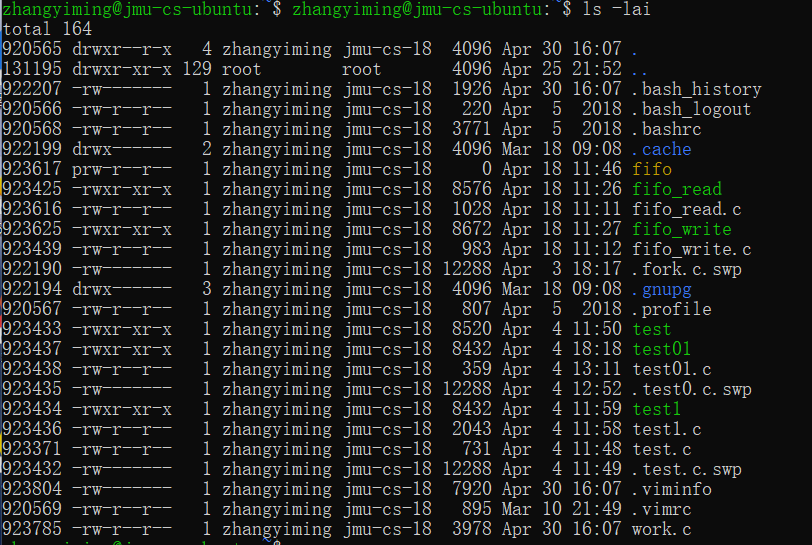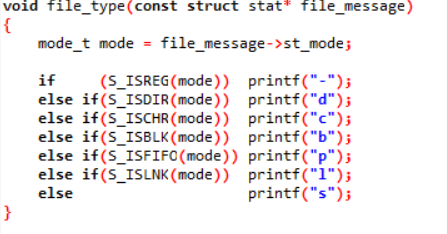操作系统第4次实验报告:文件系统
姓名:张一鸣
班级:计算1812
学号:201821121050
1. 编写程序
在服务器上用Vim编写一个程序:实现Linux系统命令ls -lai的功能,给出源代码:
源代码:
#include<stdio.h> #include<stdlib.h> #include<string.h> #include<unistd.h> #include<dirent.h> #include<sys/stat.h> #include<sys/types.h> #include<fcntl.h> #include<time.h> #include<pwd.h> #include<grp.h> void error_printf(const char* ); void list_dir(const char* ); void list_message(const char* , const struct stat*); void file_type(const struct stat* ); void file_power(const struct stat* ); void file_id(const struct stat* ); void file_mtime(const struct stat* ); void link_printf(const char* ); void error_printf(const char* funname) { perror(funname); exit(EXIT_FAILURE); } void list_dir(const char* pathname) { DIR* ret_opendir = opendir(pathname); if(ret_opendir == NULL) error_printf("opendir"); int ret_chdir = chdir(pathname); if(ret_chdir == -1) error_printf("chdir"); struct dirent* ret_readdir = NULL; while(ret_readdir = readdir(ret_opendir)) { char* filename = ret_readdir->d_name; struct stat file_message = {}; int ret_stat = lstat(filename, &file_message); if(ret_stat == -1) printf("%s error!", filename); else if(strcmp(filename,".") && strcmp(filename,"..")) list_message(filename, &file_message); } } void list_message(const char* filename, const struct stat* file_message) { file_type(file_message); printf("%d ",(int)file_message->st_ino); file_power(file_message); printf("%d ", file_message->st_nlink); file_id(file_message); printf("%5ld ", file_message->st_size); file_mtime(file_message); printf("%s ", filename); if(S_ISLNK(file_message->st_mode)) link_printf(filename); puts(""); } void file_type(const struct stat* file_message) { mode_t mode = file_message->st_mode; if (S_ISREG(mode)) printf("-"); else if(S_ISDIR(mode)) printf("d"); else if(S_ISCHR(mode)) printf("c"); else if(S_ISBLK(mode)) printf("b"); else if(S_ISFIFO(mode)) printf("p"); else if(S_ISLNK(mode)) printf("l"); else printf("s"); } void file_power(const struct stat* file_message) { mode_t mode = file_message->st_mode; printf("%c", mode&S_IRUSR?'r':'-'); printf("%c", mode&S_IWUSR?'w':'-'); printf("%c", mode&S_IXUSR?'x':'-'); printf("%c", mode&S_IRGRP?'r':'-'); printf("%c", mode&S_IWGRP?'w':'-'); printf("%c", mode&S_IXGRP?'x':'-'); printf("%c", mode&S_IROTH?'r':'-'); printf("%c", mode&S_IWOTH?'w':'-'); printf("%c ", mode&S_IXOTH?'x':'-'); } void file_id(const struct stat* file_message) { struct passwd* pwd; pwd = getpwuid(file_message->st_uid); printf("%s ",pwd->pw_name); struct group* grp; grp = getgrgid(file_message->st_gid); printf("%s ",grp->gr_name); } void file_mtime(const struct stat* file_message) { struct tm* t = localtime(&file_message->st_mtime); printf("%2d月 %2d %02d:%02d ", t->tm_mon+1, t->tm_mday, t->tm_hour, t->tm_min); } void link_printf(const char* filename) { char buf[1024] = "123"; if(0 == readlink(filename, buf, sizeof(buf))) error_printf("readlink"); printf("-> %s ",buf); } int main() { char path[1024] = {}; strcpy(path,"./"); struct stat file_message = {}; int ret_stat = lstat(path, &file_message); if(ret_stat == -1) error_printf("stat"); if(S_ISDIR(file_message.st_mode)) list_dir(path); else list_message(path, &file_message); return 0; }
2. 分析运行结果
给出运行结果截图,对于每一列是如何获取的,结合源代码做解释

第一列为文件索引号.

第二列首字母为文件类型,“-”开头的是普通文件,代表无对应条件。"p"开头的是管道文件。"rwx"分别代表具有读写执行的权限等等。

第三列为硬连接个数。

第四列为文件拥有者。

第五列为文件对应用户组的信息。

第六列为以字节为单位的文件大小。

第七列为最后修改文件的时间。

第八列为文件路径。

3. 通过该实验产生新的疑问及解答
略


 浙公网安备 33010602011771号
浙公网安备 33010602011771号